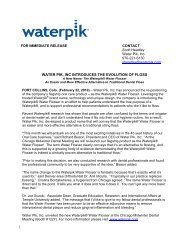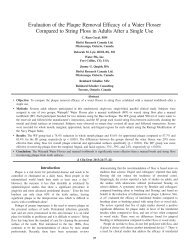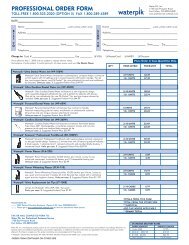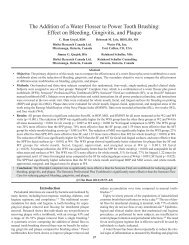Seniors and Boomers: Living Longer, Living Healthier ... - Waterpik
Seniors and Boomers: Living Longer, Living Healthier ... - Waterpik
Seniors and Boomers: Living Longer, Living Healthier ... - Waterpik
Create successful ePaper yourself
Turn your PDF publications into a flip-book with our unique Google optimized e-Paper software.
an older person’s decision to live independently. Assisted living,<br />
which allows people to have more privacy <strong>and</strong> independence<br />
yet provides some personal <strong>and</strong> nursing services as needed, is<br />
increasingly popular as are residential care facilities. Residential<br />
facilities have various levels of care in close proximity allowing<br />
people to move between arrangements as needed. 3<br />
With increasing age, living in a nursing home becomes more<br />
likely; currently, about 18% of those over 85 years reside in one.<br />
The majority (41.7%) of seniors living in a nursing home are<br />
women over age 85. Male nursing home residents are generally<br />
younger, possibly because they have higher rates of serious <strong>and</strong>/<br />
or permanent injuries at a younger age. 3<br />
CHRONIC CONDITIONS:<br />
MEDICALLY COMPLEX<br />
AND COMPROMISED<br />
As people live longer, the prevalence of disease, especially chronic<br />
disease including heart disease, chronic obstructive pulmonary<br />
disease (COPD), diabetes, <strong>and</strong> arthritis, increases. 4 Improved<br />
screenings leading to earlier detection, coupled with more effective<br />
treatments, have decreased suffering, disability, <strong>and</strong> mortality. 2,5<br />
This is evidenced by the fact that the US mortality rate continues<br />
to decline as life expectancy (now 78.7) increases. More people are<br />
living to age 65, <strong>and</strong> those who do have more years remaining than<br />
people did a century ago. 3<br />
The top four leading causes of death in older individuals are heart<br />
disease, cancer, stroke, <strong>and</strong> COPD. 3 Heart disease <strong>and</strong> cancer<br />
account for nearly half of all deaths. Diabetes <strong>and</strong> Alzheimer’s<br />
disease also are responsible for a significant number of deaths in<br />
seniors. In 2007, Alzheimer’s disease <strong>and</strong> diabetes switched places,<br />
with Alzheimer’s disease now the sixth leading cause of death <strong>and</strong><br />
diabetes the seventh. 7<br />
Heart Disease <strong>and</strong> Stroke<br />
Cardiovascular disease (CVD) is responsible for more deaths in the<br />
United States than any other cause; it claims more lives each year<br />
than cancer, lower respiratory diseases, <strong>and</strong> accidents combined. It<br />
is the leading cause of death in both men <strong>and</strong> women, accounting<br />
for one in every three deaths <strong>and</strong> approximately one death every<br />
39 seconds. Thirty-three percent of CVD deaths occur before<br />
age 75. Men are more likely to suffer a heart attack before age<br />
75, while women are more likely to suffer a stroke. The average<br />
number of life years lost due to a heart attack is 16.6. If all CVD<br />
were eliminated, life expectancy would rise by seven years. 8<br />
Ninety percent of both male <strong>and</strong> female coronary heart disease<br />
(CHD) patients are exposed to at least one of the following risk<br />
factors: hypertension, high cholesterol, cigarettes, or diabetes.<br />
With regard to stroke, hypertension <strong>and</strong> cigarette smoking are the<br />
strongest risk factors. Prevention of these risk factors in youth is<br />
thought to be a key to “successful aging.” 8<br />
High blood pressure (HBP), or hypertension, affects one in three<br />
adults, with an estimated 8% of people who have it undiagnosed.<br />
Until age 45, more men than women have HBP; between 45 <strong>and</strong><br />
64, the percentages are similar. After 64, more women than men<br />
have HBP; in adults over 65, 75% of women <strong>and</strong> 65% of men have<br />
HBP. The prevalence of hypertension in blacks is the highest in the<br />
world at 41.4%. Blacks tend to develop it earlier in life <strong>and</strong> have<br />
higher readings. Consequently, their risk of a first stroke is twice<br />
that of whites. 8<br />
Approximately 50.2% of adults have been told they have high<br />
cholesterol (at or above 200 mg/dL). Only about one-third of<br />
treated patients meet their LDL cholesterol goals. For patients<br />
with a history of CHD, only 20% are at their LDL goal. About 8%<br />
of those with high cholesterol are undiagnosed; women are more<br />
likely to be undiagnosed than men. 8<br />
Smoking is a power predictor of cardiac arrest. Smoking results<br />
in greater risk of early death—about 13.2 years earlier for men<br />
<strong>and</strong> 14.5 years earlier for women. Smokers are also more likely to<br />
experience a heart attack sooner than a nonsmoker—nine years<br />
sooner for men <strong>and</strong> 13 years sooner for women. 9 Nonsmokers<br />
exposed to secondh<strong>and</strong> smoke at home or work increase<br />
their risk of heart disease by 25%–30%. Even brief exposure to<br />
secondh<strong>and</strong> smoke can cause blood platelets to become sticky,<br />
the lining of blood vessels to be damaged, <strong>and</strong> coronary flow<br />
to decrease. 8 Older adults are less likely to smoke than those<br />
younger. Approximately 9.3% of men <strong>and</strong> 8.6% of women over age<br />
65 smoke. In this demographic, more men (54.7%) than women<br />
(29.6%) identified themselves as former smokers.<br />
Heart disease death rates in people with diabetes are 2–4 times<br />
higher than in those without diabetes. About 68% of people with<br />
diabetes die of some form of heart disease <strong>and</strong> about 16% of<br />
stroke. 10 The presence of diabetes at age 50 has been shown to<br />
confer the highest lifetime risk for cardiovascular disease of any<br />
single risk factor. 11 Other data show that for people with diabetes<br />
who are normal weight, the lifetime risk of CVD is 54.8% for women<br />
<strong>and</strong> 78.6% for men. In comparison, the lifetime risk increases for<br />
those who are obese by 78.8% for women <strong>and</strong> 86.9% for men. 8<br />
Diabetes <strong>and</strong> Obesity<br />
Diabetes affects 26.9% of people (10.9 million) ages 65 <strong>and</strong> older.<br />
Another 50% of seniors have pre-diabetes, a condition in which<br />
the fasting blood glucose is higher than normal, but not high<br />
enough to be considered diabetes. Pre-diabetes increases the risk<br />
of developing type 2 diabetes, heart disease, <strong>and</strong> stroke. Fifty-five<br />
percent of cases of diabetes are diagnosed between the ages of<br />
45 <strong>and</strong> 64. Another 20% are diagnosed at 65 or older. 10<br />
The risk of death for people with diabetes is twice that of people<br />
of a similar age without diabetes. 10 A person with diabetes who<br />
suffers a heart attack has a significantly higher mortality rate at 30<br />
days <strong>and</strong> one year post-event than those who have a heart attack<br />
<strong>and</strong> do not have diabetes. 12 It has also been shown that up to 22%<br />
of people 50–75 with type 2 diabetes may have asymptomatic<br />
coronary artery disease. 13<br />
In addition to heart disease, both type 1 <strong>and</strong> type 2 diabetes can<br />
lead to other serious complications. Diabetes is the leading cause<br />
of new cases of blindness. In those over age 40, 28.5% have<br />
retinopathy. Diabetes is also the leading cause of kidney failure,<br />
3













